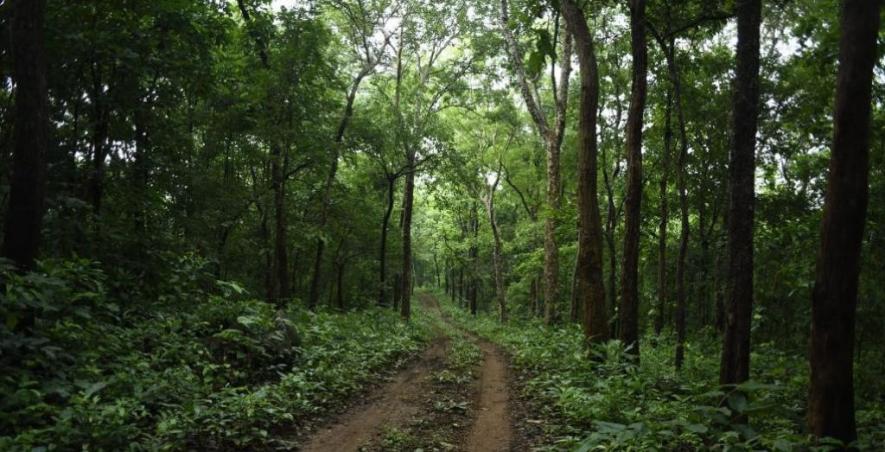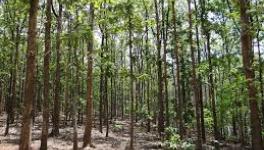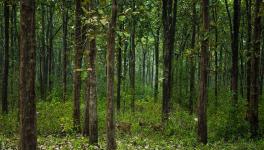What Does the India State of Forest Report 2021 Say?

Image credit: Down to Earth
On Thursday, January 13, the Ministry of Environment, Forests and Climate Change (MoEFCC) released the India State of Forest Report (ISFR) 2021. The report showed a continuing increase in forest cover across the country. However, experts have flagged some of its other aspects as causes for concern, such as a decline in forest cover in the Northeast, loss of dense forests, and an increase in forest fires.
The ISFR 2021 presents the latest status of the ‘forest cover’ and ‘tree cover’ of the country, estimates of growing stock, extent of trees outside forests, mangrove cover, bamboo resources, and assessment of forest carbon stock.
According to ISFR 2021, India has recorded an increase of 1,540 square kilometres in its forest cover. This is the increase recorded during 2019 and 2021. The last such report was published in 2019. All lands more than one hectare in area, with a tree canopy density of more than 10%, including tree orchards, bamboo, palms, etc., occurring within recorded forest and other government lands, private community or institutional lands, are included in the assessment of ‘forest cover’.
India’s total forest cover is 7,13,789 square kilometres, or 21.71% of the total geographical area of the country. India has set a target of bringing 33% of its geographical area under forest cover as envisaged in the National Forest Policy, 1988. This was also one of the key targets enlisted in the Strategy for New India @ 75 document released in December 2018 by the NITI Aayog
However, a look at the data reveals that India is not adding dense forests.
It is actually losing significant areas of natural forests with moderate tree cover. India has more forest cover with tree canopy density in the range of 10% to 40%, referred to as ‘open forest’.
The ISFR is based on four categories of forests listed by the Forest Survey of India. These categories are – Very Dense Forest (with tree canopy density of 70% or above), Moderately Dense Forest (tree canopy density of 40% or above but less than 70%), Open Forest (tree canopy density of 10% or above but less than 40%), and Scrub (tree canopy density less than 10%).
LOSS OF FOREST COVER
Open forests currently have the biggest share in the country’s forest cover, with 9.34% of the total geographical area of the country (307,120 sq km). Very dense forests account for just 3.04% (99,779 sq km) of the total geographical area, and moderately dense forests account for 9.33% (3,06,890 sq km). India’s total 7,13,789 sq km of forest cover comprises 13.97% of very dense forests, 42.99% of moderately dense forests, and 43% of open forest.
India has reported an increase of just 501 sq km under the Very Dense Forest category in the last two years. There is a loss of 1,582 sq km under the Moderately Dense Forest category. Open forests have reported an increase of 2,612 sq km.
While five states — Andhra Pradesh (647 sq km), Telangana (632 sq km), Odisha (537 sq km), Karnataka (155 sq km), and Jharkhand (110 sq km) — have contributed almost entirely to the net increase in forest cover of 1,540 sq km, several states have shown a major loss in forest cover. They are – Arunachal Pradesh (257 sq km), Manipur (249 sq km), Nagaland (235 sq km), Mizoram (286 sq km), and Meghalaya (73 sq km).
Eleven states have reported a loss in forest cover while 21 states and Union territories have reported losses in moderately dense forest cover. The report said, “The loss in Forest Cover and deterioration of forest canopy may be attributed to shifting cultivation, felling of trees, natural calamities, anthropogenic pressure and developmental activities.”
NORTHEASTERN STATES VULNERABLE
The northeastern states of India — Arunachal Pradesh, Assam, Manipur, Nagaland, Tripura, Mizoram, Meghalaya, and Sikkim — account for 23.75% of the country’s total forest cover. These states have lost a total of 1,020 sq km of forest during 2019-2021, according to the report. Among the eight states, Manipur recorded the largest loss in forest cover, followed by Nagaland and Mizoram.
The northeastern states have been losing forest cover consistently, as the last report published in 2019 also indicated. Between 2011 and 2019, forest cover of six states, excluding Assam, had decreased by nearly 18%. The region lost nearly 25,012 sq km of forest cover in the preceding decade.
INCREASE IN FOREST FIRES
India reported a total of 3,45,989 forest fires from November 2020 to June 2021, according to the ISFR 2021. This is the highest recorded in the country for this period so far. At least 2,58,480 forest fires were reported during the same time in 2018-19, and were the second-highest so far, according to data presented by Ashwini Kumar Choubey, minister of state in the Union environment ministry, in the Rajya Sabha December 16, 2021.
Odisha reported the maximum number of fires among all states (51,968), followed by Madhya Pradesh (47,795) and Chhattisgarh (38,106). Uttarakhand recorded the sixth-highest fire counts in the country; incidences were up 28.3 times this forest fire season compared to last.
The report said, “Persistent hotter and drier weather due to climate change and other human factors such as land conversion for agriculture and poor forest management are the main drivers behind the increase of forest fire.” It added, “In India, severe fires occur in many forest types, particularly dry deciduous forest, while evergreen, semi-evergreen and montane temperate forests are comparatively less prone. More than 36% of the country’s forest cover has been estimated to be prone to frequent forest fires/ Nearly 4% of the country’s forest cover is extremely prone to fire, whereas 6% of forest cover is found to be very highly fire prone.”
So, while on the one hand, India’s forest cover has increased, experts wonder whether it’s a good thing because the country is losing very dense forests and moderately dense forests, while only the area covered by open forests is increasing. This is a cause for concern, because the recent amendments to the Forest Act, 1980 are likely to further make the diversion of forest land for non-forest use easier. As much as 55,430.13 hectares of forest land across the country was approved for non-forestry use under the Forest (Conservation) Act, 1980 between April 2018 and March 2021, according to data presented by the Union Ministry of Environment, Forest and Climate Change.
Get the latest reports & analysis with people's perspective on Protests, movements & deep analytical videos, discussions of the current affairs in your Telegram app. Subscribe to NewsClick's Telegram channel & get Real-Time updates on stories, as they get published on our website.
























